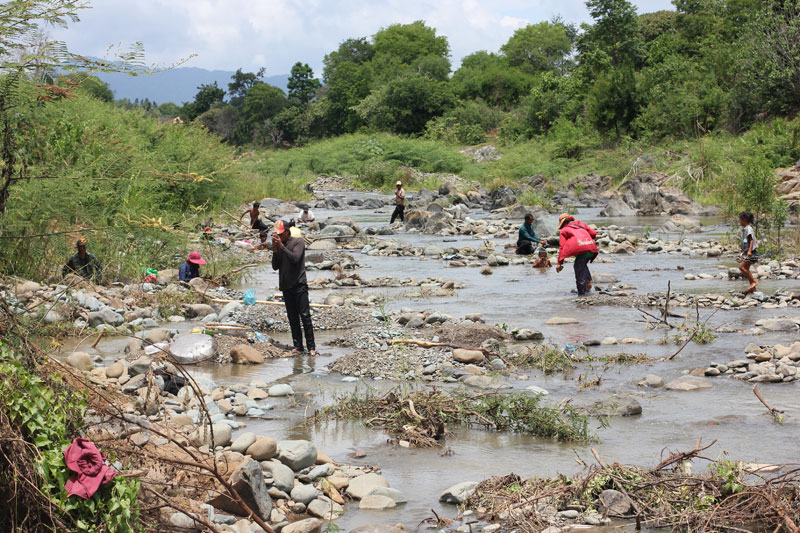PAILIN PROVINCE – Late last month, Nhem Bunna, a retired government soldier, struck it lucky here like few have since Ieng Sary led his Khmer Rouge rebels to defect to Phnom Penh in 1996.
Clutching his index finger below the top joint, his feet still in the silt of a gem-mining brook, Mr. Bunna, 47, demonstrated the size of the large, clear ruby that washed up in his pan.

Once a mining haven, the gems in this former Khmer Rouge stronghold have long since vanished, making the find an extraordinary one. Mr. Bunna said he sold the stone to one of the many traders plying Pailin for $6,000.
“Since I found that big ruby, these other people have flocked to find them too,” Mr. Bunna said on Monday. “But what I found was just a small remnant of what was left behind by the big Thai companies.”
As Mr. Bunna spoke, about 40 other locals dived in and out of crudely excavated pockets of the stream, shoveling the river silt into pans to be sifted.
For many, however, the most they can expect to find is a small ruby or sapphire scarcely larger than a piece of rock salt, and worth only enough to see them through a few days.
But it wasn’t always this way. Famous for its richness in gems since the late colonial era, the area saw a fading of fortunes with the defection of local Khmer Rouge units to the government almost two decades ago.
In March 1997, six months after Pailin’s defection, a military official here estimated that concessions granted by the Khmer Rouge for Thai companies to mine gems had brought in $20 million a year since 1993.
You Bun, 70, a former guerrilla who was at the brook on Monday, said he had been panning for gems around Pailin since before the area was taken by the Khmer Rouge as a strategic redoubt after 1979.
In those days, before Thai companies and their dredging machines arrived, Mr. Bun said sizable stones were far more common. Nevertheless, he felt encouraged by Mr. Bunna’s recent discovery.
“When I had a lot of energy, I found such big rubies too,” he said.
“In the past, I could sometimes find rubies that were worth between $3,000 and $4,000…. Now, when we’re lucky, on some days we are able to make 40,000 to 100,000 riel [$10 to $25],” Mr. Bun said. “Other times, we can’t make any money for a week or two.”
Miners out panning on Monday said they only looked for precious stones when they weren’t working as hired farm hands on the many plantations now popping up on agro-industry concessions around Pailin.
“This job is very tiring but we have to be patient with this because we don’t know what else to do,” said Ros Thea, 55, who has an illicit mine with a water pump behind the new luxury Memoria Palace hotel.
Even Mr. Bunna, who found the $6,000 ruby, said he had used most of the money to pay off a loan he had taken out years ago in a failed effort to grow corn and cassava on a leased plot of farmland.

Large gems dried up here at the close of the 1990s, according to most residents, with the Thai companies pulling out their machines and leaving the region to pursue agricultural projects.
In an indication of the exhaustion, Pailin’s leadership at the time —led in relative autonomy from Phnom Penh by ex-Khmer Rouge military commander Y Chhien—finally gave in to requests from the government to let it regulate the gem trade in September 2000.
Mr. Chhien, now 63, who served as Pol Pot’s chief bodyguard, had risen in importance after the Chinese government in 1991 cut off its funding to the Khmer Rouge, which it had always insisted go directly through former Khmer Rouge Foreign Minister Ieng Sary.
The securing of deals with Thai companies, many of which were alleged to have direct links to the Thai military, became a central task for the survival of the rebel group along the border.
Last month, after an 18-year reign, Mr. Chhien, who declined to be interviewed for this article, stood down as Pailin governor and handed the position over to another ex-guerrilla, Koeut Sothea, who had served as one of his deputies since 1996.
Mr. Sothea said it was too late to dwell on whether the fruits of the gem trade had been adequately shared among the population by the former Khmer Rouge leaders.
“What happened before is in the past now,” Mr. Sothea said.
“We can’t rely on gemstone mining anymore because that’s gone from the war,” he added. “There are still stones but it’s a very small amount, so now the people must grow rice and set up orchards.”
The new governor said he recognized that some former guerrillas face poverty, but said many squandered fertile land by taking out risky high-interest loans and then farming without regard to rotation or climate.
“It’s not right to talk about inequality,” he said. “In general, the standard of living is good and the city is well organized, as you can see.”
Back at the brook, Chum Pheakdey, 30, said he would keep panning for stones until he finds construction work in town.
“I have never found a big piece and on some days I find nothing,” Mr. Pheakdey said. “Everything always just depends on our luck.”




